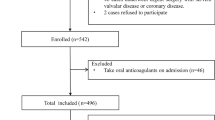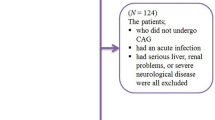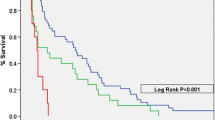Abstract
We evaluated whether modified Model for End-Stage Liver Disease (MELD) scores are useful for predicting the postdischarge prognosis in hospitalized patients with heart failure (HF) who are discharged alive. The MELD-XI and MELD-Na scores were calculated at discharge for a total of 1156 patients in the HIJ-HF II study. We also studied 3 groups on the basis of the left ventricular ejection fraction (LVEF): the HFrEF (LVEF < 40%), HFmrEF (LVEF 40–49%) and HFpEF (LVEF ≥ 50%) groups. The primary outcome was all-cause mortality, and the secondary outcome was rehospitalization due to worsening HF. The median MELD-XI and MELD-Na scores were 12 and 14, respectively. After a median follow-up of 19 months, there were significantly higher rates of all-cause mortality in patients with MELD-XI scores ≥ 12 than in those with MELD-XI scores < 12; there were also higher rates of all-cause mortality in patients with MELD-Na scores ≥ 14 than in those with MELD-Na scores < 14 (both log-rank p < 0.001). The cumulative incidence function based on a competing risks model showed a higher rate of rehospitalization due to worsening HF in patients with MELD-XI scores ≥ 12 than in those with MELD-XI scores < 12 and a higher rate of rehospitalization due to worsening HF in those with MELD-Na scores ≥ 14 than in those with MELD-Na scores < 14 (both Gray’s test p < 0.001). The adjusted hazard ratios (HRs) of all-cause mortality for patients with MELD-XI scores ≥ 12 and those with MELD-Na scores ≥ 14 were 2.07 [95% confidence interval (CI) 1.25–3.44] and 2.79 [95% CI 1.63–4.79], respectively, in the HFrEF group; however, the HRs were not significant in the HFmrEF or HFpEF groups. Thus, MELD-XI and MELD-Na scores may be useful for predicting prognosis in hospitalized HF patients who are discharged alive, especially for those in the HFrEF group.



Similar content being viewed by others
References
Damman K, Testani JM (2015) The kidney in heart failure: an update. Eur Heart J 36:1437–1444
Xanthopoulos A, Starling RC, Kitai T, Triposkiadis F (2019) Heart failure and liver disease: cardiohepatic interactions. JACC Heart Fail 7:87–97
Kamath PS, Wiesner RH, Malinchoc M, Kremers W, Therneau TM, Kosberg CL, D’Amico G, Dickson ER, Kim WR (2001) A model to predict survival in patients with end-stage liver disease. Hepatology 33:464–470
Kamath PS, Kim WR (2007) The model for end-stage liver disease (MELD). Hepatology 45:797–805
Matthews JC, Pagani FD, Haft JW, Koelling TM, Naftel DC, Aaronson KD (2010) Model for end-stage liver disease score predicts left ventricular assist device operative transfusion requirements, morbidity, and mortality. Circulation 121:214–220
Yang JA, Kato TS, Shulman BP, Takayama H, Farr M, Jorde UP, Mancini DM, Naka Y, Schulze PC (2012) Liver dysfunction as a predictor of outcomes in patients with advanced heart failure requiring ventricular assist device support: use of the model of endstage liver disease (MELD) and MELD eXcluding INR (MELD-XI) scoring system. J Heart Lung Transplant 31:601–610
Kim MS, Kato TS, Farr M, Wu C, Givens RC, Collado E, Mancini DM, Schulze PC (2013) Hepatic dysfunction in ambulatory patients with heart failure: application of the MELD scoring system for outcome prediction. J Am Coll Cardiol 61:2253–2261
Biegus J, Zymlinski R, Sokolski M, Siwolowski P, Gajewski P, Nawrocka-Millward S, Poniewierka E, Jankowska EA, Banasiak W, Ponikowski P (2016) Impaired hepato-renal function defined by the MELD XI score as prognosticator in acute heart failure. Eur J Heart Fail 18:1518–1521
Grodin JL, Gallup D, Anstrom KJ, Felker GM, Chen HH, Tang WHW (2017) Implications of alternative hepatorenal prognostic scoring systems in acute heart failure (from DOSE-AHF and ROSE-AHF). Am J Cardiol 119:2003–2009
Biegus J, Demissei B, Postmus D, Cotter G, Davison BA, Felker GM, Filippatos G, Gimpelewicz C, Greenberg B, Metra M, Severin T, Teerlink JR, Voors AA, Ponikowski P (2019) Hepatorenal dysfunction identifies high-risk patients with acute heart failure: insights from the RELAX-AHF trial. ESC Heart Fail 6:1188–1198
McDonagh TA, Metra M, Adamo M, Gardner RS, Baumbach A, Böhm M, Burri H, Butler J, Čelutkienė J, Chioncel O, Cleland JGF, Coats AJS, Crespo-Leiro MG, Farmakis D, Gilard M, Heymans S, Hoes AW, Jaarsma T, Jankowska EA, Lainscak M, Lam CSP, Lyon AR, McMurray JJV, Mebazaa A, Mindham R, Muneretto C, Francesco Piepoli M, Price S, Rosano GMC, Ruschitzka F, Kathrine Skibelund A, ESC Scientific Document Group (2021) 2021 ESC Guidelines for the diagnosis and treatment of acute and chronic heart failure. Eur Heart J 42:3599–3726
Shiga T, Suzuki A, Haruta S, Mori F, Ota Y, Yagi M, Oka T, Tanaka H, Murasaki S, Yamauchi T, Katoh J, Hattori H, Kikuchi N, Watanabe E, Yamada Y, Haruki S, Kogure T, Suzuki T, Uetsuka Y, Hagiwara N, HIJ-HFII Investigators (2019) Clinical characteristics of hospitalized heart failure patients with preserved, mid-range, and reduced ejection fractions in Japan. ESC Heart Fail 6:475–486
Heuman DM, Mihas AA, Habib A, Gilles HS, Stravitz RT, Sanyal AJ, Fisher RA (2007) MELD-XI: a rational approach to “sickest first” liver transplantation in cirrhotic patients requiring anticoagulant therapy. Liver Transpl 13:30–37
Bettari L, Fiuzat M, Felker GM, O’Connor CM (2012) Significance of hyponatremia in heart failure. Heart Fail Rev 17:17–26
Kim WR, Biggins SW, Kremers WK, Wiesner RH, Kamath PS, Benson JT, Edwards E, Therneau TM (2008) Hyponatremia and mortality among patients on the liver-transplant waiting list. N Engl J Med 359:1018–1026
Chioncel O, Collins SP, Greene SJ, Pang PS, Ambrosy AP, Antohi EL, Vaduganathan M, Butler J, Gheorghiade M (2017) Predictors of post-discharge mortality among patients hospitalized for acute heart failure. Card Fail Rev 3:122–129
Shinagawa H, Inomata T, Koitabashi T, Nakano H, Takeuchi I, Naruke T, Ohsaka T, Nishii M, Takehana H, Izumi T (2008) Prognostic significance of increased serum bilirubin levels coincident with cardiac decompensation in chronic heart failure. Circ J 72:364–369
Ambrosy AP, Vaduganathan M, Huffman MD, Khan S, Kwasny MJ, Fought AJ, Maggioni AP, Swedberg K, Konstam MA, Zannad F, Gheorghiade M, EVEREST Trial Investigators (2012) Clinical course and predictive value of liver function tests in patients hospitalized for worsening heart failure with reduced ejection fraction: an analysis of the EVEREST trial. Eur J Heart Fail 14:302–311
Samsky MD, Dunning A, DeVore AD, Schulte PJ, Starling RC, Tang WH, Armstrong PW, Ezekowitz JA, Butler J, McMurray JJ, Teerlink JR, Voors AA, Metra M, Mentz RJ, O’Connor CM, Patel CB, Hernandez AF (2016) Liver function tests in patients with acute heart failure and associated outcomes: insights from ASCEND-HF. Eur J Heart Fail 18:424–432
Hillege HL, Girbes AR, de Kam PJ, Boomsma F, de Zeeuw D, Charlesworth A, Hampton JR, van Veldhuisen DJ (2000) Renal function, neurohormonal activation, and survival in patients with chronic heart failure. Circulation 102:203–210
Metra M, Cotter G, Gheorghiade M, Dei Cas L, Voors AA (2012) The role of the kidney in heart failure. Eur Heart J 33:2135–2142
Gheorghiade M, Abraham WT, Albert NM, Gattis Stough W, Greenberg BH, O’Connor CM, She L, Yancy CW, Young J, Fonarow GC, OPTIMIZE-HF Investigators and Coordinators (2007) Relationship between admission serum sodium concentration and clinical outcomes in patients hospitalized for heart failure: an analysis from the OPTIMIZE-HF registry. Eur Heart J 28:980–988
Lee SE, Choi DJ, Yoon CH, Oh IY, Jeon ES, Kim JJ, Cho MC, Chae SC, Ryu KH, Oh BH, Registry KorHF (2012) Improvement of hyponatraemia during hospitalisation for acute heart failure is not associated with improvement of prognosis: an analysis from the Korean Heart Failure (KorHF) registry. Heart 98:1798–1804
Levy WC, Mozaffarian D, Linker DT, Sutradhar SC, Anker SD, Cropp AB, Anand I, Maggioni A, Burton P, Sullivan MD, Pitt B, Poole-Wilson PA, Mann DL, Packer M (2006) The Seattle Heart Failure Model: prediction of survival in heart failure. Circulation 113:1424–1433
Shiraishi Y, Kohsaka S, Nagai T, Goda A, Mizuno A, Nagatomo Y, Sujino Y, Fukuoka R, Sawano M, Kohno T, Fukuda K, Anzai T, Shadman R, Dardas T, Levy WC, Yoshikawa T (2019) Validation and recalibration of Seattle heart failure model in Japanese acute heart failure patients. J Card Fail 25:561–567
Pocock SJ, Ariti CA, McMurray JJ, Maggioni A, Køber L, Squire IB, Swedberg K, Dobson J, Poppe KK, Whalley GA, Doughty RN, Meta-Analysis Global Group in Chronic Heart Failure (2013) Predicting survival in heart failure: a risk score based on 39 372 patients from 30 studies. Eur Heart J 34:1404–1413
Kitagawa T, Hidaka T, Watanabe N, Naka M, Yamaguchi M, Kanai K, Isobe M, Kihara Y, Nakano Y, Investigators REAL-HF (2022) Current conditions and significance of outpatient cardiac rehabilitation and home nursing-care services in heart failure patients with mid-range or preserved ejection fraction: post-hoc analysis of the REAL-HF registry. Heart Vessels 37:745–754
Watanabe Y, Horiuchi Y, Nakase M, Setoguchi N, Ishizawa T, Sekiguchi M, Nonaka H, Nakajima M, Asami M, Yahagi K, Komiyama K, Yuzawa H, Tanaka J, Aoki J, Tanabe K (2022) Malnutrition, hemodynamics and inflammation in heart failure with reduced, mildly reduced and preserved ejection fraction. Heart Vessels 37:1841–1849
Acknowledgements
We thank Ms. Emi Sawada and Ms. Satsuki Sato for their assistance. This work was supported by the Japan Agency for Medical Research and Development Grant [grant number 15ek0210009h0003].
Author information
Authors and Affiliations
Corresponding author
Ethics declarations
Conflict of interest
Dr. Shiga received lecture fees and research funding from Daiichi-Sankyo. Dr. Hagiwara received research funding from Eisai, Nippon Boehringer Ingelheim and Daiichi-Sankyo and received lecture fees from Nippon Boehringer Ingelheim and Bristol-Myers Squibb. The other authors have nothing to disclose.
Additional information
Publisher's Note
Springer Nature remains neutral with regard to jurisdictional claims in published maps and institutional affiliations.
Supplementary Information
Below is the link to the electronic supplementary material.
Rights and permissions
Springer Nature or its licensor (e.g. a society or other partner) holds exclusive rights to this article under a publishing agreement with the author(s) or other rightsholder(s); author self-archiving of the accepted manuscript version of this article is solely governed by the terms of such publishing agreement and applicable law.
About this article
Cite this article
Gotou, M., Suzuki, A., Shiga, T. et al. Implication of modified MELD scores for postdischarge prognosis in hospitalized patients with heart failure. Heart Vessels 38, 535–542 (2023). https://doi.org/10.1007/s00380-022-02202-z
Received:
Accepted:
Published:
Issue Date:
DOI: https://doi.org/10.1007/s00380-022-02202-z




